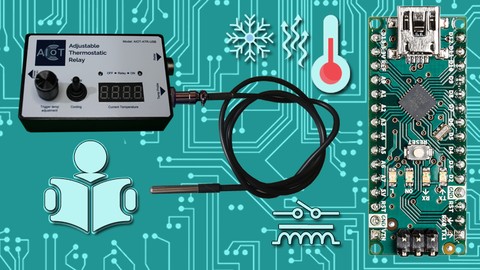
Free Download Arduino Nano Thermostatic Relay Learning Project
Published 4/2024
Created by Richard Inniss
MP4 | Video: h264, 1280x720 | Audio: AAC, 44.1 KHz, 2 Ch
Genre: eLearning | Language: English | Duration: 31 Lectures ( 3h 19m ) | Size: 4 GB
A fun project to learn the Arduino Nano and how to build your own Adjustable Temperature Monitoring and Control Device
What you'll learn:
You'll learn how to use the Arduino Nano in the context of a project to display and adjust both LOW & HIGH temperature limits and automatically actuate a RELAY.
Learn how to use a DS18B20 Waterproof Temperature Sensor, the TM1637 7-Segment 4-digit LED Display, the rotary encoder and much more.
Learn how to use a single Momentary Push Button to control multiple items by discerning between a "SHORT PRESS" and a "LONG PRESS".
Basic refresher courses on the Arduino Nano, the Arduino IDE (IDE) or Integrated Development Environment as well as C++ for beginners.
Learn how to use the Arduino EEPROM library to store and reload important information even after power outages.
Build a professional looking Automated Thermostatic Relay unit enclosed in a project box using downloadable drill hole templates and labels.
Requirements:
A basic understanding of electronics
A computer along with basic computer skills
Some basic electronic parts are required (covered in lecture 3)
No paid software required - the Arduino IDE and all required code are free to downloads
Description:
In this course, you'll not only learn about the Arduino Nano, you'll also learn how to build a fully automated and user Adjustable Thermostatic Relay. At the end of this course, you'll have built and programmed your very own Adjustable Thermostatic Relay and learned many new things about the Arduino Nano microcontroller, how to use a DS18B20 Waterproof Temperature Sensor, the TM1637 7-Segment 4-digit LED Display, the rotary encoder and so much moreIf you are an absolute beginner, the course also includes introduction modules on the Arduino Nano, how to install the IDE (Integrated Development Environment) software, as well as a basic refresher on C++ to help the beginner level students. We will simplify your learning experience as we supply all the code and make it easy for you to follow step-by-step instructions, as we explain each line of the code. We'll also encourage and point you to some resources and exercises outside the course to familiarize yourself with some of the required tools, and in no time, you will have a good understanding of the basics.The fact that their are so many real world applications for this type of a device is compelling enough for us to have created this course. Whether you're looking for a way to keep the liquid temperature of some container between certain values, or want to cool something which is getting to hot, this practical project will help you achieve this.We also show you how to display a warning message which will scroll on your LED display when a certain predefined condition occurs as well help guide you in building a more permanent and portable version of the Thermostatic Relay using an external power supply.So, we hope you decide to join us on this exciting learning adventure, and I'll see you in the next lecture.
Who this course is for:
Electronics enthusiasts.
If you'd like to learn how to automate equipment based on sensor data.
Anyone interested in learning how to create great projects using an Arduino microcontroller.
Homepage
Recommend Download Link Hight Speed | Please Say Thanks Keep Topic Live
No Password - Links are Interchangeable







